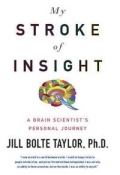
Note: This is book #38 in my 52 Books in 52 Weeks challenge for 2008.
In My Stroke of Insight: A Brain Scientist’s Personal Journey, author Jill Bolte Taylor takes us through her autobiographical account of what it was like for her to have a stroke. And not just a little one. This was a really massive blowout that did severe damage and left her in an almost child like state. With the left side of her brain swimming in blood (fun fact: raw blood is toxic to our precious, irreplaceable neurons), Taylor not only required invasive brain surgery, but also assistance from others to relearn almost everything about how to be a human being. Perhaps aptly, her greatest source of aid and care giving is her mother, who gets to repeat Taylor’s childhood, complete with helping her to learn through play, teaching her to read, providing her sensory stimulation for (re)development, and instructing her on the basic life skills that one usually associates with babies and toddlers. A good chunk of the book retells the morning of Taylor’s stroke (with great clarity and detail), her rush to the hospital, the rapid unraveling of her mind, and her long return trip to normalcy and health. Spoiler alert: she made it.
And of course beyond this the book’s hook is that the author just happens to be a brain scientist, someone who has made her career studying the human brain at a little place back East called Harvard. So the appeal to me was the streak of science worked through the fabric of her story, including discussions on how the brain works, how strokes work, and how the brain STOPS working so well when the two get together. In an effort to keep the book more mainstream Taylor holds the science parts at a pretty high level, limiting things to right brain and left brain. I’m pretty sure that brain researchers could point to diagrams of gray matter with labels that rhyme with things like ooblongdoggle hypothancum and tell you that it controls our ability to figure out what 10% off a $.89 can of pinto beans would be, but Taylor shoves everything into either the right brain or left brain buckets.
Indeed the best parts of the book are where Taylor is melding this kind of brain science with her personal accounts, like when she describes how her wounded brain had to relearn the concept of edges in objects and figure out that stepping on the cracks between concrete sidewalk slabs was okay, but stepping on the edges to the right of the sidewalk was tricky, because that was a curb she could stumble off of. The early parts of the book are full of little tidbits like this, and it’s a good melding of science and personal story. I just wish there were more of it.
Unfortunately, Taylor periodically traipses off into dippy hippy la-la land with prolonged discussions about how to control her positive energy, how to meditate on her mood, and how to be a really super all around pleasant person just by thinking about how the right side chunk of her brain works in the wake of the stroke. There’s little science in these parts to appease the left part of your brain, and things really did get far out, man. It was about the time that she was talking about how our right brains control our ability to send “waves of healing energy” to those around us that I lost most of my interest in the remainder of the book. If you feel the same way, feel free to stop reading about there.
Do you like these book reviews? Check out my profile on Goodreads.com.
Others doing the 52-in-52 thing this week:
- Jeremy reviews Bonk: The Curious Coupling of Science and Sex by Mary Roach
- Heliologue reviews Neither Here Nor There by Bill Bryson
- Nick reviews Ivanhoe by Walter Scott
Published by